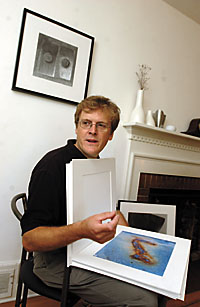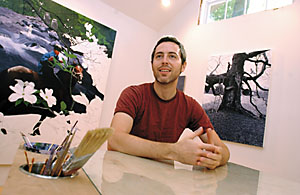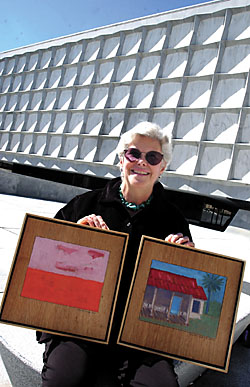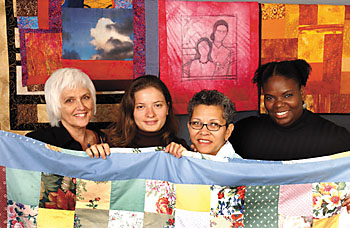 | Photographer Marc Pypaert says he is most interested "in the geometry of things." His abstract works are designed to lure viewers "to move up close." |
Below are brief profiles of just some of the Yale-affiliated artists participating in this year's City-Wide Open Studios (CWOS), a visual arts festival taking place during the month of October (see related story.)
CWOS weekend: Oct. 29-30, Alternative Space, 91 Shelton Ave. Pypaert exhibited in CWOS for the first time in 2004.
Marc Pypaert is always on the lookout for interesting objects to photograph in black-and-white or color, approaching his art in a manner that borders on the scientific.
It isn't necessarily the objects themselves that become his focus, but their details: the colors and patterns and the contrasts of light and shadow.
Using his Nikon F3 camera, for example, Pypaert photographed at close range the rust that had formed on a metal railing. His color photograph captured the intricate patterns and color variations in the rust against the deep blue railing, creating an entire "landscape" of its own.
The sea-salt adhering to a wooden post on Cape Cod, the cracking paint on a metal vase, a fragment of a fountain in Paris or one tiny section of tree bark can spark Pypaert's artistic imagination.
"I'm interested in the abstract, in the geometry of things," says the photographer. "When you look at my images, you're not really sure what you're looking at. I want people, when they see a particular work from a distance, not to know what it is. I want them to come closer to it, to move up close."
In Yale's Electron Microscopy Core Facility, where he has worked for six years, Pypaert takes pictures for other scientists engaged in research, and he sometimes zooms in on the microscopic. Looking at such objects as cells or tissues, the scientist says, he often marvels "at the beauty of life."
His pictures, many of which resemble the paintings of abstract or surrealist artists, are a reflection of that same awe of everyday life and scenes of it, he says.
"I know that something like rust may not appeal to someone, but if you look past it as a form of decay, and see it as part of the object, something beautiful comes out of it."
In his search for artistic subjects, Pypaert says he spends much of his time bent over, looking at things below him as he walks.
"People probably think I'm crazy; I'll sometimes just get down on my knees to look closely at something in the road or in the dirt."
He is drawn to the unexpected results of film photography and says he so savors experimenting with his camera that he avoids studying other photographers' work or processes, so as to remain free of external influence. He also refrains from using a flash, a light meter or other external devices.
"I like the idea of photographing something just as it is, where you get what you see," Pypaert says. He is also resistant to photographing with a digital camera.
"I like the paper film -- the idea that you don't see what you've created until you get the contacts. But I'm nervous that someday paper film will be extinct."
Pypaert's wife, Christine Deloyer, is a jewelry artisan and will also participate in CWOS in the alternative space.
CWOS weekend: Oct. 22 and 23; in his Hamden studio at 15 Lake St. He has been a CWOS exhibitor for several years.
While studying drawing and painting at Marlboro College and Boston University, where he earned an M.F.A., Christopher Mir absorbed the ideas and techniques of master artists throughout history as well as from his instructors and forged them into an artistic style and process that is uniquely his own.
He rebels against the notion of some that copying from others' pictures, for example, is a cop-out, instead inserting his hand-copied images from magazines and books into scenes with subjects drawn entirely from his own imagination.
Working with acrylic or oil paint, Mir creates scenes that are a blend of the real and the surreal, often seemingly mystical or dream-like in their weaving of incongruous elements and their mixture of color and black-and-white.
In his paintings, tropical-looking flowers are set against a background of snow-covered mountains; a fur-clad Eskimo stands in a lush-green, purple-flowered field as a helicopter approaches in the distance; and a Jesus-like figure, painted in black-and-white, holds onto a snake, as northern birds fly in different directions near an aqua mountain lake.
"People often ask me, 'What's the narrative?'" says Mir. "I resist that. I want the viewer to bring his or her own story to the picture. What I can say is that in most of my work, people are usually acting out some religious, mythological or personal drama."
Mir also revisits a few motifs in his work, such as a little-boy and Jesus-like character he refers to as "the wanderer," and a goddess or "supermodel" figure. He is also drawn, he comments, to creating scenes of an "apocalyptic, futuristic world."
"Sometimes I'll incorporate over and over in my paintings the same figure from a photograph, but each time in a different context," he says. "There is this kind of talismanic quality to some of my source material."
The artist says that he is always "hungry" for new figures or scenes that can serve as his subjects, and he digs through many sources, ranging from old National Geographic travel books to newspapers to the Internet.
Mir minored in anthropology as an undergraduate, and his artistry is often inspired by mythology, Native American traditions or primitive spiritual beliefs, such as Shamanism.
"Art, for me, is really taking possession of something by re-making it in your own hand," he says. "I mean, that has been the urge since cave painters -- that effort to re-make the world, internalize it, and project it out again."
Mir currently has a special interest in creating landscapes that have some elements in color and others in black-and-white. "I'm interested in that combination and I really like the way it looks because it does something to the psychology of the work, where it is almost like a dream space," says the painter.
Mir's work has been exhibited in group and solo shows in New York City, Los Angeles, New Haven and other venues, and the Yale University Art Gallery has purchased one of his works.
Working in a backyard studio he shares with his wife, painter Karen Dow (Yale M.F.A. '98), Mir generally paints for four to five hours a day.
"When I am painting, it is like a Zen experience," he comments. "I'm not in my head."
Dow will also show her abstract paintings in CWOS, alongside her husband.
CWOS weekend: Oct. 29 and 30, Alternative Space. This will be Nangle's second CWOS exhibition.
Natural vistas -- be it the sea, a marsh, the sky or a field of trees -- are common subjects in Karen Nangle's oil paintings on wood and her pastels.
A student at Vassar College in the days when studio art, she says, "was not considered intellectual enough to be a major," Nangle majored in art history and nevertheless spent much of her time painting. She had her first exhibition shortly after graduating from college. She later took formal classes at the Parsons School of Design and the Art Students League, and studied both oil painting and frame making with artist and designer Robert Kulicke.
In an artist's statement she wrote, Nangle says that painting landscapes on wood allows her to "articulate what I could not find the words to say. Unspoiled horizons spawn peace and tranquility and nourish the soul."
Nangle began painting on wood because she enjoys the feel of the wood's grain, as well as the "serendipitous" outcome when she slides her brush against the wood to paint grass or trees or the ocean. She also creates her own wooden frames, a talent she learned from Kulicke, who designed the now ubiquitous Plexi-box frame used by galleries.
Over a decade ago, Nangle began drawing in pastels while making long car trips to visit her two children at various schools. The habit was useful later when she moved to Savannah, Georgia, and made occasional long trips by car to visit with family in the Northeast.
"I passed the time by doing pastels, capturing landscape scenes as we traveled," she says.
"My interest in my art is to catch a feeling of the light, or the pattern, or the textures of what I am painting," says Nangle. "I don't like getting caught up in the particulars of the scene unless I am doing an architectural drawing. I'm more interested in conveying a feeling of a scene through those elements."
Well-versed in the techniques of various famous artists through the ages, Nangle says her favorites include Mark Rothko, Pierre Bonnard, Milton Avery and Matisse. She is also fond of a number of Japanese printmakers. Some of these artists, she says, particularly Rothko, have had a "subconscious" influence on her work.
Nangle has been featured in several solo shows in New York City and in Savannah, and has received several awards and fellowships in recognition of her work. While in Savannah, she drew the birthplace of Girl Scout founder Juliette Gordon Low and other points of interest to the Girl Scouts as well as historic Savannah landmarks. She sold these drawings in print, postcard and notecard form as part of a series called Girl Scouts Savannah.
The painter -- whose husband, Bob, and son Fred are both Yale graduates -- has also created some drawings of Yale buildings, and says that, had she been able to devote her entire career to art, she "would have made a picture of every single Yale building."
"I sometimes wonder what my life would have been like if I had lived it in the manner of such women artists as Georgia O'Keefe, Mary Cassatt, Helen Frankenthaler or others, instead of leading the pretty traditional life I have had, with a family and a career," says Nangle, who has been at the Beinecke Library since January. "Grandma Moses is definitely my idol. I always wanted to have it all. But not many women artists managed to achieve that."
Members include Yvette Barnard, coordinator of Dossier Services, Graduate School of Arts and Sciences; Kimberly Juanita Brown, graduate student in African American studies and American studies; Pat Cabral, assistant to the dean, Graduate School Office for Diversity and Equal Opportunity; Victorine Shepard, graduate registrar in American studies; and Suzanna Urminska and Catherine Whalen, graduate students in American studies
CWOS weekend: Oct. 29 and 30, Alternative Space. This will be the group's first CWOS exhibition.
Twice a month, a group of students and staff members from the Graduate School of Arts and Sciences, known informally as Battin' and Chattin', gather on campus to make quilts.
They enjoy the camaraderie as they socialize while stitching the colorful fabrics of their self-designed quilts, and those more experienced in the art share their expertise with those who are new at it.
The group members -- who come from diverse backgrounds and are of varied ages -- have also come to share a concern for some 400 women and girls who have been murdered over the past decade in the industrial Mexican city of Ciudad de Juarez. Most of the women were poor and their bodies were dumped in vacant lots in the city. In addition, many other women from Ciudad de Juarez are listed as "missing." The situation has attracted international attention and raised criticism that Mexican authorities are not interested in solving the crimes.
For this year's CWOS, the women will donate the quilts they have made to the international cause. Seven will be auctioned off, with the proceeds going to organizations dedicated to achieving justice for the murdered women.
The quilters learned about the situation in Ciudad de Juarez from Alicia Schmidt Camacho, an assistant professor of American studies. Battin' and Chattin' member Kimberly Juanita Brown suggested having a silent auction at CWOS, and the other members decided to make special quilts or donate ones they were already working on. Liza Cariaga-Lo, assistant dean of diversity at the Graduate School, eagerly supported the community project by paying the $50 registration fee required for artists to participate in CWOS.
"Ideally, we would like our quilts to end up in public places, such as with organizations, museums or university departments, so people can see them, rather than having them in someone's home," says Brown, whose CWOS quilt is decorated with a poem she wrote called "For the Lost," in remembrance of Ciudad de Juarez's murdered women.
Battin' and Chattin' was started by Heather Williams, who received her Ph.D. in American studies at Yale in 2002. It is a fluid group, with some Yale staff members who are permanent fixtures, some students who eventually move on and other students who retain their ties even after graduation. The latter includes Graduate School alumna Françoise Hamlin, who now teaches at the University of Massachusetts at Amherst. She has donated two of her quilts to the CWOS silent auction.
The quilts created by Battin' and Chattin' are as unique as the individual members themselves.
Pat Cabral, a self-taught quilter who works on a wide variety of creative crafts, especially enjoys making quilts to give as gifts. "I know I could go out and buy a quilt as a gift, but making it for someone has more meaning," she says.
The floral quilt she has donated to the CWOS silent auction was originally meant to be the first quilt she made for herself. "When Kimberly approached me with the idea of donating quilts, I decided to give it up," comments Cabral, who has worked at Yale for 24 years.
Victorine Shepard joined Battin' and Chattin' about three years ago after she couldn't cajole its founder into making her a quilt. Instead, she was invited to join the group so she could make one herself.
While she jokes that she has since "cursed" Williams every time she sticks herself with a needle, Shepard says she is grateful to be helping in a community cause via CWOS. "Where art serves social justice is the best intersection, and I am very interested in putting my energies into that," says Shepard, who has worked at Yale for 18 years.
New member Suzanna Urminska, who is also a photographer, says quilting has filled in for another artistic endeavor she once pursued: creating collages.
"There's something important to me about working with material fragments," says the third-year graduate student. "There is incompleteness to a quilt even when it is finished. It has a resonance to collage for me, and I also enjoy doing art projects that employ critical thinking or have some kind of social action behind them."
Brown, who says she was "dragged" to Battin' and Chattin' by a friend several years ago, has since become one of the group's most dedicated members.
"There is something about the precision of the art that I like, as well as the soft, cushiony feel of the quilts," says the sixth-year graduate student.
All of the Yale affiliates are looking forward to their first experience at CWOS and share a common goal for the event.
"We hope we sell all of our quilts," explains Brown, eliciting nods of agreement from her fellow quilters.
Schmidt Camacho and Melissa Garcia, a graduate student in American studies, are handling the administrative aspects of the CWOS silent auction. They can be contacted via e-mail for further information about the auction or about the murders in Ciudad de Juarez at alicia.camacho@yale.edu or gmelissa.garcia@yale.edu.
-- By Susan Gonzalez
T H I S
Yale community members will share their unique artistic visions at City-Wide Open Studios
Marc Pypaert, photography
Research scientist in cell biology and director of the Electron Microscopy Core Facility

Painter Christopher Mir blends the real and the surreal in his oil and acrylic works to create often-mystical images that invite the viewer to "bring his or her own story to the picture."
Christopher Mir, painting
Museum technician, Yale University Art Gallery

In her paintings and pastels, Karen Nangle aims to "catch a feeling of the light, or the pattern, or the textures" of a landscape rather than the "particulars of the scene."
Karen Nangle, paintings/pastels
Library services assistant, Beinecke Rare Book and Manuscript Library

The Battin' and Chattin' quilting group will auction off its members' creations to support efforts to bring justice for the over 400 murdered women and girls in the Mexican city of Ciudad de Juarez. Pictured here with some of the group's creations are (from left) Victorine Shepard, Suzanna Urminska, Pat Cabral and Kimberly Juanita Brown.
Battin' and Chattin', quilts
 W E E K ' S
W E E K ' S S T O R I E S
S T O R I E S![]()
 Archaeologist's discovery may be final clue to location of long-lost Maya city
Archaeologist's discovery may be final clue to location of long-lost Maya city![]()
![]()
 Materials research center established with $7.5 million NSF grant
Materials research center established with $7.5 million NSF grant![]()
![]()
 Annual festival lets local artists showcase their works
Annual festival lets local artists showcase their works![]()
![]()
 Yale community members will share their unique artistic visions . . .
Yale community members will share their unique artistic visions . . .![]()
![]()
 Message from the Leaders of the Yale United Way Campaign
Message from the Leaders of the Yale United Way Campaign![]()
![]()
 Welcome, Parents! A schedule of Parents' Weekend activities
Welcome, Parents! A schedule of Parents' Weekend activities![]()
![]()
 Matching fund for Katrina relief expanded
Matching fund for Katrina relief expanded![]()
![]()
 IN FOCUS: OFFICE OF SUSTAINABILITY
IN FOCUS: OFFICE OF SUSTAINABILITY
 New office adds energy to the drive for a 'greener' campus
New office adds energy to the drive for a 'greener' campus![]()
 One step at a time, student group hopes to change habits of peers
One step at a time, student group hopes to change habits of peers![]()
 Actions you can take to help make Yale a sustainable campus
Actions you can take to help make Yale a sustainable campus![]()
![]()
 'Skeptical' neurologist works to separate science from sham
'Skeptical' neurologist works to separate science from sham![]()
![]()
 Yale Rep launches its 40th season with 'The Cherry Orchard'
Yale Rep launches its 40th season with 'The Cherry Orchard'![]()
![]()
 Special packages for Yale community
Special packages for Yale community![]()
![]()
 Exhibition simulates viewing conditions intended by artists
Exhibition simulates viewing conditions intended by artists![]()
![]()
 Noted graphic designer Dan Friedman is subject of retrospective
Noted graphic designer Dan Friedman is subject of retrospective![]()
![]()
 MEDICAL SCHOOL NEWS
MEDICAL SCHOOL NEWS
 Study shows how hospitals can improve heart attack care
Study shows how hospitals can improve heart attack care![]()
 Aneurysm reduces risk of atherosclerosis, say researchers
Aneurysm reduces risk of atherosclerosis, say researchers![]()
 Scientists identify gene that controls severity of asthma
Scientists identify gene that controls severity of asthma![]()
 Report: Better training in telephone medicine needed
Report: Better training in telephone medicine needed![]()
 Discovery may help improve diagnosis and treatment of MS
Discovery may help improve diagnosis and treatment of MS![]()
 Study: Hypersensitive neurons at root of 'phantom pain'
Study: Hypersensitive neurons at root of 'phantom pain'![]()
 Study: Genetic factors for gambling, depression overlap
Study: Genetic factors for gambling, depression overlap![]()
 Program shown to curb high-risk behavior in teens
Program shown to curb high-risk behavior in teens![]()
 Physician: More research funding needed to prevent . . .
Physician: More research funding needed to prevent . . .![]()
![]()
 Divinity School alumni will honor memory of missing classmate . . .
Divinity School alumni will honor memory of missing classmate . . .![]()
![]()
 Audience will be 'postmodern detectives' in School of Drama play
Audience will be 'postmodern detectives' in School of Drama play![]()
![]()
 New visions of religious icons featured in ISM show
New visions of religious icons featured in ISM show![]()
![]()
 Exhibit celebrates life of Yale's first Native American alumnus
Exhibit celebrates life of Yale's first Native American alumnus![]()
![]()
 WFF will honor women leaders from around the globe
WFF will honor women leaders from around the globe![]()
![]()
 Annual festival will include music, talks and shadow puppetry
Annual festival will include music, talks and shadow puppetry![]()
![]()
 Study shows stigma of obesity influenced by attitudes of peers
Study shows stigma of obesity influenced by attitudes of peers![]()
![]()
 Book doctor
Book doctor![]()
![]()
 YUWO awards scholarships to 13 Yale affiliates
YUWO awards scholarships to 13 Yale affiliates![]()
![]()
 Yale Books in Brief
Yale Books in Brief![]()
![]()
 Campus Notes
Campus Notes![]()
Bulletin Home |
| Visiting on Campus
Visiting on Campus |
| Calendar of Events
Calendar of Events |
| In the News
In the News![]()
Bulletin Board |
| Classified Ads
Classified Ads |
| Search Archives
Search Archives |
| Deadlines
Deadlines![]()
Bulletin Staff |
| Public Affairs
Public Affairs |
| News Releases
News Releases |
| E-Mail Us
E-Mail Us |
| Yale Home
Yale Home